Measurement and Spatial Variation of Green Total Factor Productivity of the Tourism Industry in China
Abstract
:1. Introduction
2. Literature Review
3. Materials and Methods
3.1. Study Area
3.2. Study Methods
3.2.1. Calculation Method for Carbon Emissions and the Consumption of Energy Related to the Tourism Industry
3.2.2. Data Envelopment Analysis (DEA) Model and the ML Index
3.3. Index Selection and Data Sources
4. Research Process and Results
4.1. Temporal Features and Spatial Differences of Carbon Emissions and the Consumption of Energy
4.1.1. Temporal Features of Carbon Emissions and the Consumption of Energy
4.1.2. Space Characteristic of Carbon Emissions and the Consumption of Energy
4.2. Temporal Evolution and Regional Differences of GTFP of China’s Tourism Industry
4.2.1. Temporal Evolution of GTFP of China’s Tourism Industry
4.2.2. Spatial Pattern of GTFP for the Tourism Industry in China
5. Discussion and Conclusions
Author Contributions
Funding
Acknowledgments
Conflicts of Interest
References
- Wang, K.; Li, J.; Xi, J.C. Linking between carbon dioxide emission and tourism economic growth in China. Tour. Trib. 2014, 29, 24–33. [Google Scholar]
- Pan, Z.Q.; Liang, B.E. Research on space-time heterogeneity of tourism industry carbon emission intensity distribution and influencing factors: Analysis of panel data from 30 provinces (cities and districts) from 2005 to 2014. Hum. Georg. 2016, 6, 152–158. [Google Scholar]
- Sanzidur, R.; Ruhul, S. Six decades of total factor productivity change and sources of growth in Bangladesh agriculture (1948–2008). J. Agric. Econ. 2013, 64, 275–294. [Google Scholar]
- Zhang, J.D.; Qu, X.Y.; Sangaiah, A.K. A study of green development mode and total factor productivity of the food industry based on the industrial Internet of things. IEEE Commun. Mag. 2018, 56, 72–78. [Google Scholar] [CrossRef]
- Morfeldt, J.; Silveira, S. Capturing energy efficiency in European iron and steel production-comparing specific energy consumption and Malmquist productivity index. Energy Effic. 2014, 7, 955–972. [Google Scholar] [CrossRef]
- Long, X.; Zhao, X.; Cheng, F. The comparison analysis of total factor productivity and eco-efficiency in China’s cement manufactures. Energy Policy 2015, 81, 61–66. [Google Scholar] [CrossRef]
- Zhang, N.; Wang, B. A deterministic parametric meta-frontier luenberger indicator for measuring environmentally-sensitive productivity growth: A Korean fossil-fuel power case. J. Energy Econ. 2015, 51, 88–98. [Google Scholar] [CrossRef]
- Giang, M.; Xuan, T.; Trung, B.; Que, M.; Yoshida, Y. Impact of investment climate on total factor productivity of manufacturing firms in Vietnam. J. Sustain. 2018, 10, 4815. [Google Scholar] [CrossRef] [Green Version]
- Han, H.; Zhong, Z.; Wen, C.; Sun, H. Agricultural environmental total factor productivity in China under technological heterogeneity: Characteristics and determinants. Environ. Sci. Pollut. Res. Int. 2018, 25, 32096–32111. [Google Scholar] [CrossRef]
- Liu, Z.Y.; Sun, X.L. The temporal-spatial evolution and motivation analysis of green total factor productivity in Chinese logistics industry. Soft Sci. 2018, 32, 77–81. [Google Scholar]
- Hu, B.; Cai, L. Hotel labor productivity assessment: A data envelopment analysis. J. Travel Tour. Market. 2004, 17, 39–50. [Google Scholar] [CrossRef]
- Sigala, M. Using data envelopment analysis for measuring and benchmarking productivity in the hotel sector. J. Travel Tour. Market. 2004, 16, 31–51. [Google Scholar] [CrossRef]
- Peypoch, N.; Sbai, S. Productivity growth and biased technological change: The case of Moroccan hotels. Int. J. Hosp. Manag. 2011, 30, 136–140. [Google Scholar] [CrossRef]
- Barros, C.P.; Matias, A. Assessing the efficiency of travel agencies with a stochastic cost frontier: A Portuguese case study. Int. J. Tour. Res. 2006, 8, 367–379. [Google Scholar] [CrossRef]
- Koksa1, C.D.; Aksu, A.A. Efficiency evaluation of a-group travel agencies with data envelopment analysis(DEA): A case study in the Antalya region, Turkey. Tour. Manag. 2007, 28, 830–834. [Google Scholar] [CrossRef]
- Fuentes, R.; Alvarez-Suarez, A. Productivity of travel agencies in Spain: The case of Alicante. Serv. Ind. J. 2012, 32, 2623–2640. [Google Scholar] [CrossRef]
- Fernandes, E.; Pacheco, R. Efficiency use of airport capacity. Transp. Res. Part A 2006, 32, 225–238. [Google Scholar]
- Wanke, P.; Barros, C.P.; Nwaogbe, O.R. Assessing productive efficiency in Nigerian airports using Fuzzy-DEA. J. Transp. Policy 2016, 49, 9–19. [Google Scholar] [CrossRef]
- Lee, C.K.; Han, S.H. Estimating the use and preservation values of national parks’ tourism resources using a contingent valuation method. Tour. Manag. 2002, 23, 531–540. [Google Scholar] [CrossRef]
- Preda, P.; Watts, T. Improving the efficiency of sporting venues through capacity management: The case of the Sydney(Australia)cricket ground trust. Event Manag. 2003, 8, 83–89. [Google Scholar] [CrossRef] [Green Version]
- Ding, Z.M.; Lai, Q.F.; Huang, X.J.; Zhu, J.J.; Lin, P.P. Study on the spatial differences and convergences of the tourism efficiency in the forest parks of China. For. Econ. 2016, 38, 41–48. [Google Scholar]
- Wang, Y.G. An empirical study on TFP growth in China’s tourism industry. J. Inq. Econ. Issue 2012, 3, 175–180. [Google Scholar]
- Wu, L.P. Estimation of total factor productivity of China’s tourism industry. Stat. Decis. 2017, 9, 135–139. [Google Scholar]
- Zha, J.P.; Qian, X.B.; Zhao, Q.Q.; Shu, H.Y. Estimation and decomposition of total factors productivity of China’s tourism. J. Resour. Sci. 2018, 40, 2461–2474. [Google Scholar]
- Yuan, Y.J. Tourism in China: Indirect energy conception and carbon emissions. J. Tour. Trib. 2013, 10, 81–88. [Google Scholar]
- Becken, S.; Simmons, D.G.; Frampton, C. Energy use associated with different travel choices. J. Tour. Manag. 2003, 24, 267–277. [Google Scholar] [CrossRef]
- Howitt, O.J.A.; Revol, V.G.N.; Smith, I.J.; Rodger, C.J. Carbon emissions from international cruise ship passengers’ travel to and from New Zealand. Energy Policy 2010, 38, 2552–2560. [Google Scholar] [CrossRef]
- Wei, Y.X.; Sun, G.N.; Ma, L.J.; Li, J. Estimating the carbon emissions and regional differences of tourism transport in China. J. Shaanxi Nom. Univ. 2012, 40, 76–84. [Google Scholar]
- Shi, P.H.; Wu, P. A rough estimation of energy consumption and CO2 emission in tourism sector of China. Acta Geogr. Sin. 2011, 66, 235–243. [Google Scholar]
- Bruno, D.B.; Kristiaan, K. Cost efficiency of belgian local governments: A comparative analysis of FDH, DEA, and econometric approaches. Reg. Sci. Urban Econ. 1996, 26, 145–170. [Google Scholar]
- Giokas, D.I.; Pentzaropoulos, G.C. Efficiency ranking of the OECD member states in the area of telecommunications: A composite AHP/DEA study. Telecommun. Pol. 2008, 32, 672–685. [Google Scholar] [CrossRef]
- Chung, Y.; Fare, R. Productivity and undesirable outputs: A directional distance function approach. J. Microecon. 1995, 51, 229–240. [Google Scholar] [CrossRef] [Green Version]
- Kumar, S. Environmentally sensitive productivity growth: A global analysis using Malmquist–Luenberger index. Ecol. Econ. 2006, 56, 280–293. [Google Scholar] [CrossRef]
- The Ministry of Culture and Tourism Released the 2018 Statistical Bulletin on Cultural and Tourism Development. Available online: http://www.gov.cn/xinwen/2019-05/30/content_5396055.htm (accessed on 8 February 2020).
- He, J.M. Research on the high quality development system and strategy of China’s tourism industry in the new era. Tour. Trib. 2016, 33, 9–11. [Google Scholar]
- Han, Y.J.; Wu, P.; Lin, T. Regional tourism industry’ efficiency measurement and comparative analysis based on carbon emissions. Geogr. Res. 2015, 34, 153–166. [Google Scholar]
- Zhong, Y.D. Carbon emission measurement and ecological efficiency evaluation of tourism industry. Tour. Trib. 2016, 31, 11–12. [Google Scholar]
- Dubois, G.; Ceron, J.P. Tourism/leisure greenhouse gas emissions forecasts for 2050: Factors for change in France. J. Sustain. Tour. 2006, 2, 172–191. [Google Scholar] [CrossRef]
- Perch-Nielsen, S.; Sesartic, A.; Stucki, M. The greenhouse gas intensity of the tourism sector: The case of Switzerland. Environ. Sci. Policy 2010, 13, 131–140. [Google Scholar] [CrossRef]
- Dwyer, L.; Forsyth, P.; Spurr, R.; Hoque, S. Estimating the carbon footprint of Australian tourism. J. Sustain. Tour. 2010, 3, 355–376. [Google Scholar] [CrossRef]
- Zaman, K.; Khan, M.M.; Ahmad, M. Exploring the relationship between tourism development indicators and carbon emissions: A case study of Pakistan. World Appl. Sci. J. 2011, 5, 690–701. [Google Scholar]
- Bhuiyan, M.A.H.; Bari, M.A.; Siwar, C.; Ismail, S.M.; Islam, R. Measurement of carbon dioxide emissions for eco-tourism in Malaysia. Appl. Sci. 2012, 19, 1832–1838. [Google Scholar] [CrossRef]
- Kelly, J.; Williams, P.W. Modelling tourism destination energy consumption and greenhouse gas emissions: Whistler, British Columbia, Canada. J. Sustain. Tour. 2007, 1, 67–90. [Google Scholar] [CrossRef]
- Peeters, P.; Schouten, F. Reducing the ecological footprint of inbound tourism and transport to Amsterdam. J. Sustain. Tour. 2007, 2, 157–171. [Google Scholar] [CrossRef]
- Becken, S.; Patterson, M. Measuring national carbon dioxide emissions from tourism as a key step towards achieving sustainable tourism. J. Sustain. Tour. 2006, 14, 323–338. [Google Scholar] [CrossRef]
- Zhao, G.Q.; Zhang, Z.Y. Uncovering the relationship between FDI, human capital and technological progress in Chinese high-technology industries. China World Econ. 2010, 18, 82–98. [Google Scholar] [CrossRef]
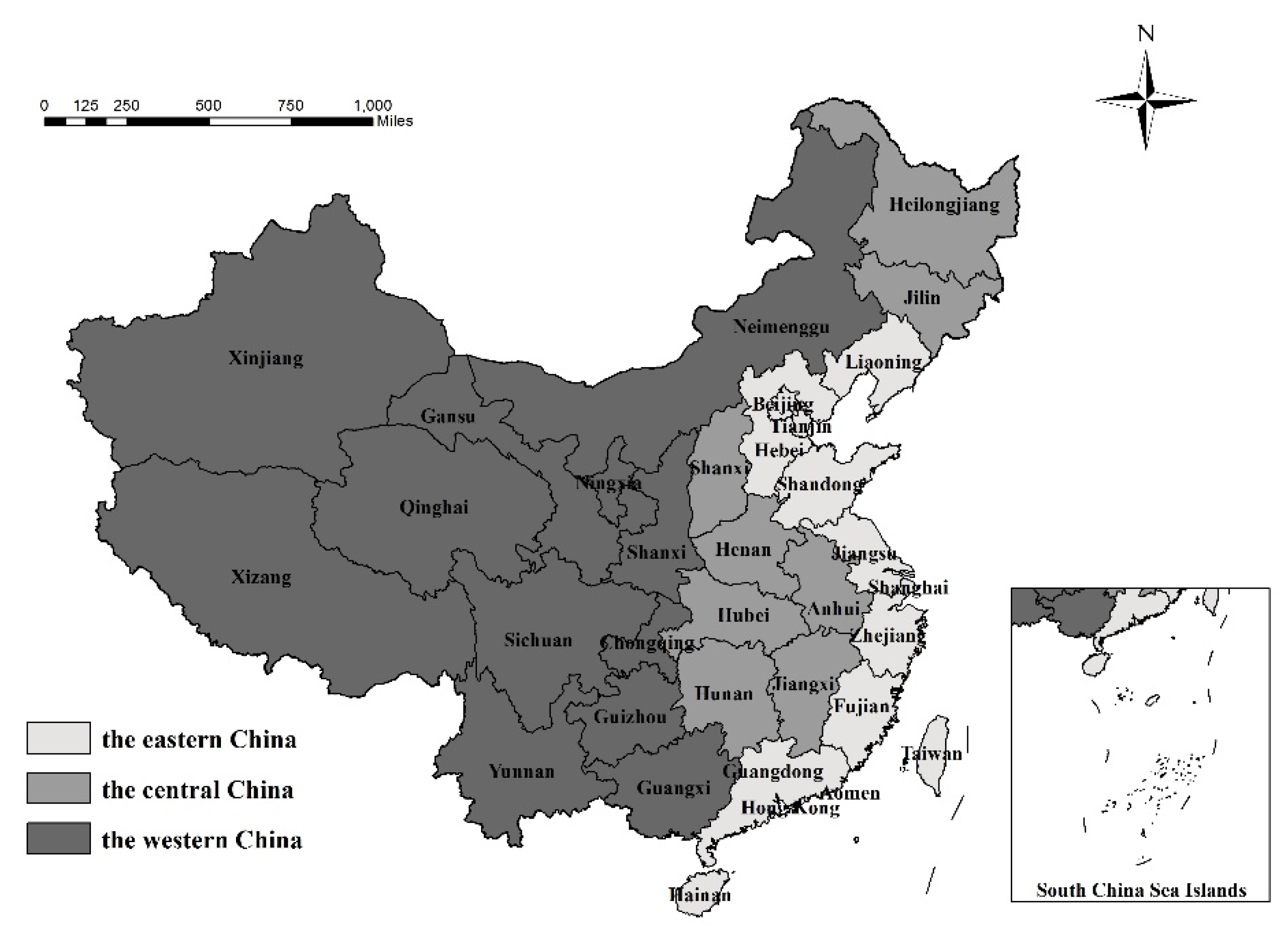

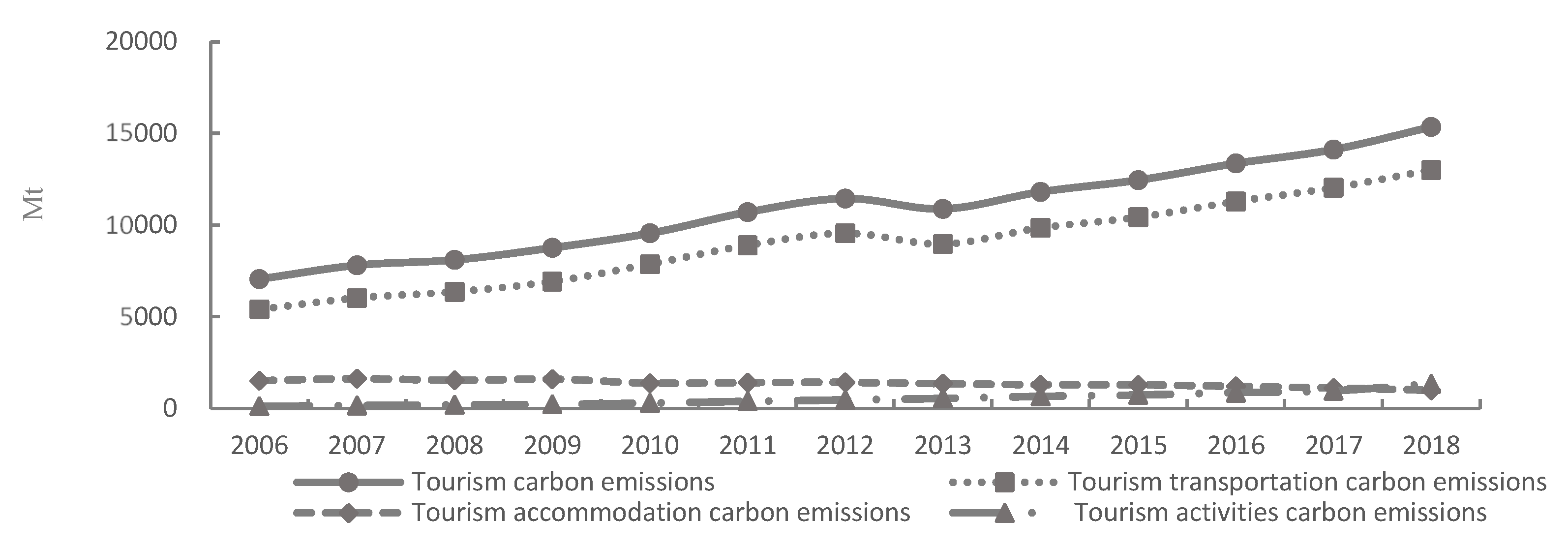


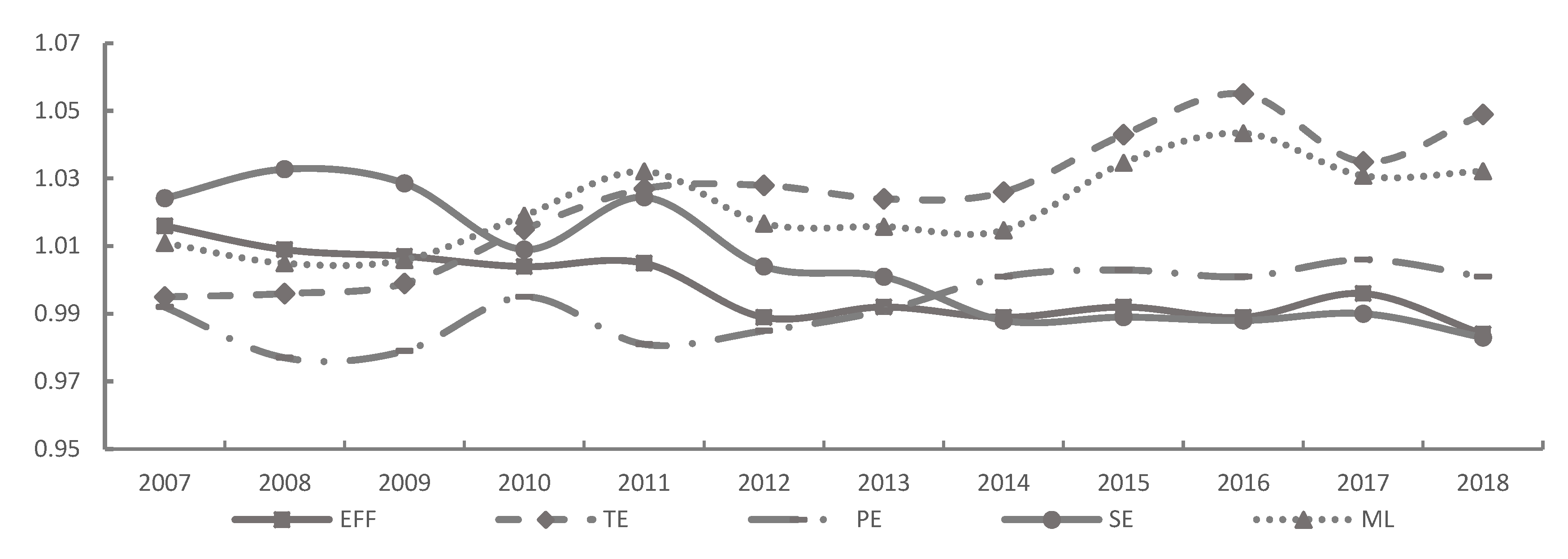
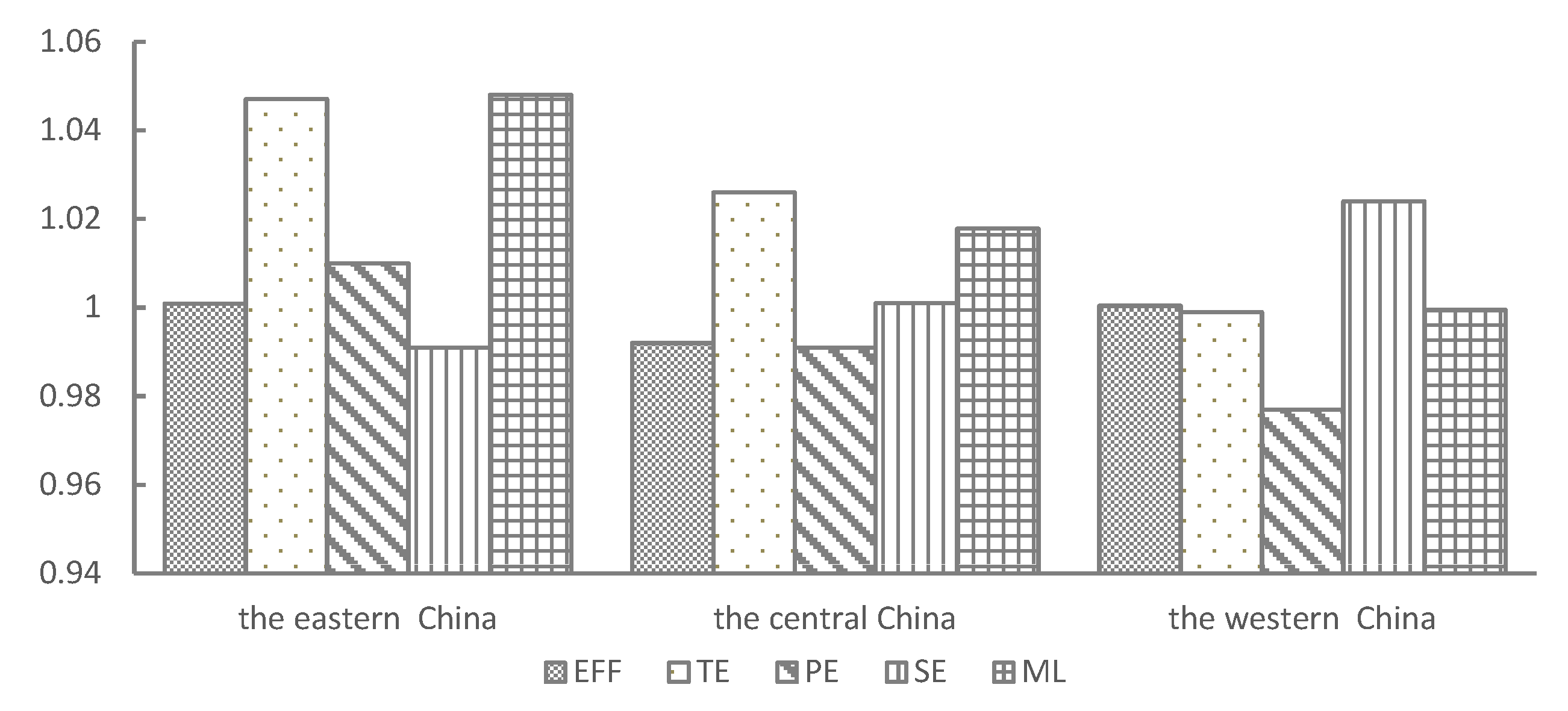
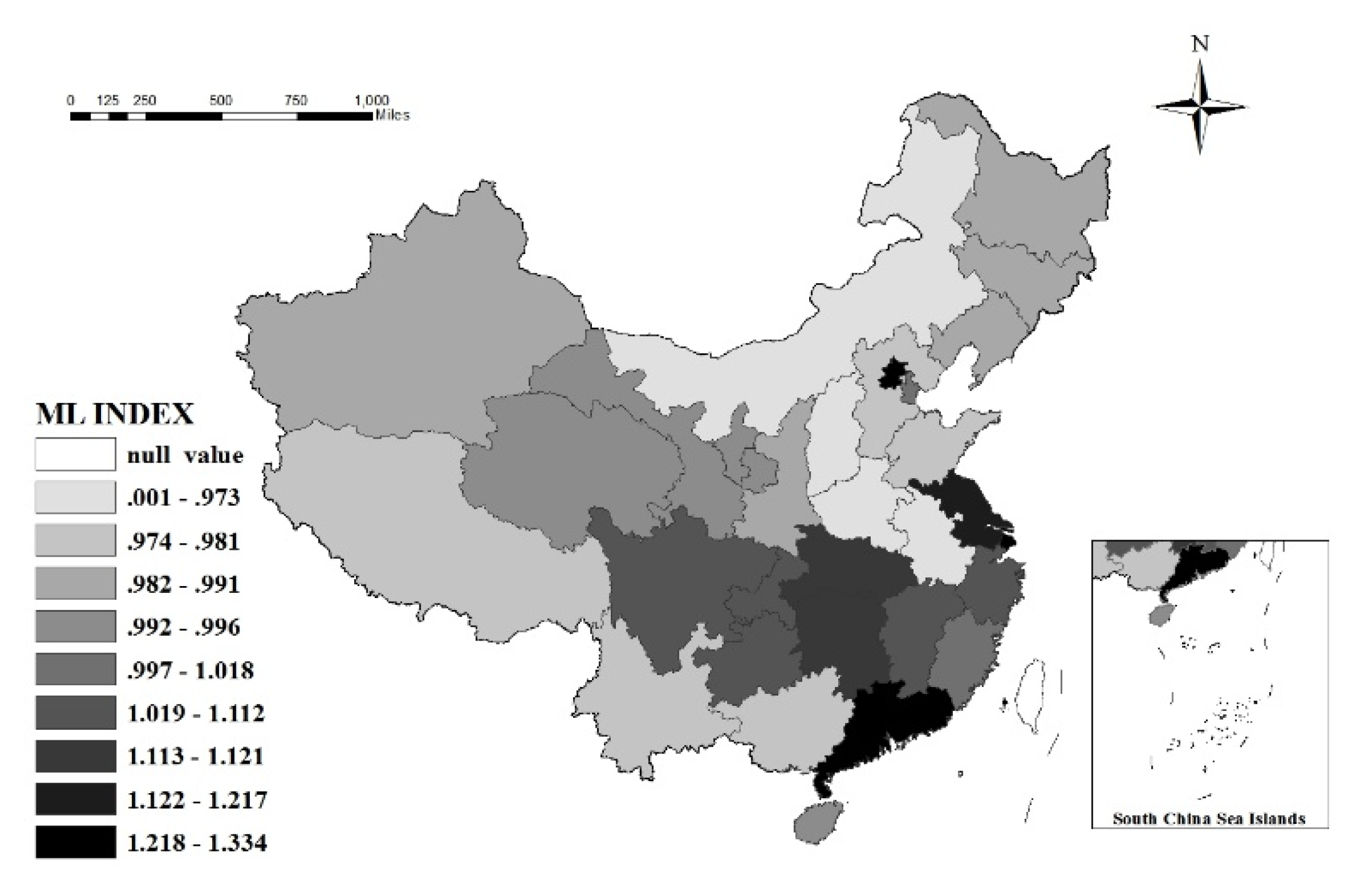
| Tourism Transportation (Mt/MJ) | Tourism Accommodation (Mt/MJ) | Tourism Activities (Mt/MJ) | ||||
|---|---|---|---|---|---|---|
| Carbon Emissions | Energy Consumption | Carbon Emissions | Energy Consumption | Carbon Emissions | Energy Consumption | |
| 2006 | 5406.25 | 888.81 | 1520.29 | 75.21 | 129.71 | 25.23 |
| 2007 | 6024.13 | 997.60 | 1626.61 | 102.57 | 161.57 | 30.83 |
| 2008 | 6361.16 | 1055.53 | 1541.50 | 97.21 | 199.77 | 37.71 |
| 2009 | 6923.07 | 1137.50 | 1606.86 | 101.33 | 234.29 | 44.16 |
| 2010 | 7873.76 | 1290.39 | 1387.55 | 87.50 | 295.35 | 55.19 |
| 2011 | 8898.05 | 1452.95 | 1415.40 | 89.25 | 393.51 | 73.33 |
| 2012 | 9558.88 | 1550.01 | 1427.93 | 90.04 | 468.97 | 86.80 |
| 2013 | 8972.85 | 1492.79 | 1357.35 | 85.59 | 551.46 | 101.60 |
| 2014 | 9847.96 | 1639.41 | 1301.23 | 80.16 | 665.06 | 124.09 |
| 2015 | 10424.99 | 1733.29 | 1292.06 | 78.95 | 740.21 | 139.29 |
| 2016 | 11287.10 | 1872.19 | 1206.63 | 76.47 | 869.74 | 155.95 |
| 2017 | 12037.19 | 1952.37 | 1120.71 | 74.35 | 967.95 | 175.36 |
| 2018 | 13001.65 | 2108.52 | 1001.29 | 73.25 | 1348.76 | 186.58 |
© 2020 by the authors. Licensee MDPI, Basel, Switzerland. This article is an open access article distributed under the terms and conditions of the Creative Commons Attribution (CC BY) license (http://creativecommons.org/licenses/by/4.0/).
Share and Cite
Li, X.; Shi, P.; Han, Y.; Deng, A.; Liu, D. Measurement and Spatial Variation of Green Total Factor Productivity of the Tourism Industry in China. Int. J. Environ. Res. Public Health 2020, 17, 1159. https://doi.org/10.3390/ijerph17041159
Li X, Shi P, Han Y, Deng A, Liu D. Measurement and Spatial Variation of Green Total Factor Productivity of the Tourism Industry in China. International Journal of Environmental Research and Public Health. 2020; 17(4):1159. https://doi.org/10.3390/ijerph17041159
Chicago/Turabian StyleLi, Xingming, Pengfei Shi, Yazhi Han, Aimin Deng, and Duan Liu. 2020. "Measurement and Spatial Variation of Green Total Factor Productivity of the Tourism Industry in China" International Journal of Environmental Research and Public Health 17, no. 4: 1159. https://doi.org/10.3390/ijerph17041159




